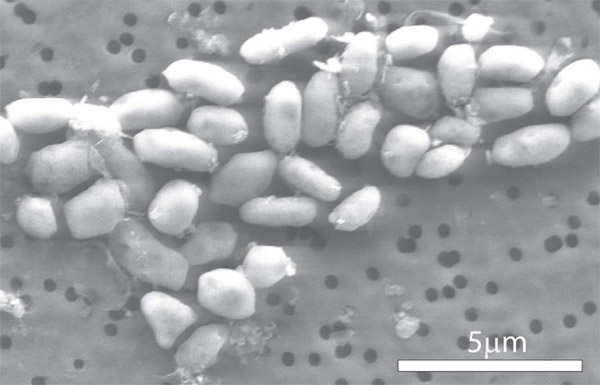Debate Reignited Over Claim of Arsenic-Based Life

One of the more heated scientific debates of recent years has been stirred up again with the publication of new criticisms of the reported finding of "arsenic life."
The prestigious journal Science published the criticisms today (May 27) along with a defense of the study, which Science had posted online this past December.
A team of researchers led by Felisa Wolfe-Simon of NASA's Astrobiology Institute had studied bacteria collected from California's Mono Lake and reported finding evidence that these microorganisms were substituting the poisonous molecule arsenic for the phosphorous usually used to build DNA.
The discovery stood to overthrow scientists' understanding of the basic requirements for life.
Igniting a firestorm
The December report in Science was immediately met with skepticism from other scientists, as the journal noted today.
"Science received a wide range of correspondence that raised specific concerns about the Research Article's methods and interpretations," editor-in-chief Bruce Alberts wrote.
Get the world’s most fascinating discoveries delivered straight to your inbox.
Others put it more bluntly: "The paper was harshly criticized for its lack of controls and unjustified conclusions," zoologist Rosemary Redfield of Canada's University of British Columbia wrote on her blog today.
Redfield wrote one of eight "technical comments," pointing out potential errors in the findings, that were published today by Science. [Q&A: 'Science' Journal Official Talks Arsenic-Based Life]
"These post-publication responses are an essential part of the process by which science moves forward, correcting itself when necessary," according to a statement from Science. "We hope that the study and the subsequent exchange being published today will stimulate further experiments — whether they support or overturn this conclusion. In either case, the overall result will advance our knowledge about conditions that support life."
Along with the criticisms, Science published a response from Wolfe-Simon and her colleagues, who say they stand by their findings and are not discouraged by the arguments against their research.
"We welcome the opportunity to better explain our methods and results and to consider alternative interpretations," Wolfe-Simon and her team wrote. "We maintain that our interpretation of [arsenic] substitution, based on multiple congruent lines of evidence, is viable."
Feeding on poison
The researchers studied a strain of bacteria called GFAJ-1. These bacteria are normally exposed to high doses of arsenic in Mono Lake.
To test whether the microbes had evolved to use the arsenic in any way, Wolfe-Simon and her colleagues tried to grow some in laboratory cultures containing only trace amounts of phosphorous. In one set of cultures, the researchers added arsenic and observed that the bacteria were thriving. In a control culture with the same small amount of phosphorous, but where no arsenic was added, the bacteria did not grow.
The researchers conducted further tests, including an analysis of the organisms' DNA, which appeared to contain arsenic. The scientists concluded that GFAJ-1 was substituting arsenic in place of phosphorous when building its DNA.
Although arsenic is typically toxic to life, its chemical properties are similar to those of phosphorous. Phosphorous is thought to be one of six elements ?along with oxygen, carbon, hydrogen, nitrogen and sulfur ?essential for life.
If it turns out that arsenic can be subbed in for phosphorous, it opens up a whole new set of possibilities for the basic requirements of life.
Pointing out problems
Detractors of the claim say there are various flaws in the Wolfe-Simon team's logic.
Redfield questions whether the researchers had done enough to eliminate possible phosphorus contamination in their cultures, and suggested that more than trace amounts of phosphorous (enough to feed the bacteria) were available to the bacteria in the lab tests.
Another problem, according to Steven Benner at the Foundation for Applied Molecular Evolution in Gainesville, Fla., is that the form of arsenic that would be present in DNA — a compound called arsenate esters — should dissolve in water, rendering it unstable in DNA.
In their response, Wolfe-Simon and her colleagues acknowledged Benner's concern but suggested that in large biomolecules like DNA, arsenate esters might be more stable than thought.
And Barbara Schoepp-Cothenet from the Bioénergétique et Ingénierie des Protéines in Marseilles, France, argued that arsenic would likely be reduced to a different compound called arsenite in the environment of a cell. While arsenic does have similar properties to phosphorous, arsenite does not, and should not be able to mimic phosphorous' functions in DNA, she said.
But the researchers said they had seen no evidence of arsenite in their follow-up studies of the bacteria growing in the cultures.
Unresolved
Ultimately, the case is far from settled.
The Wolfe-Simon team has offered to provide samples of the GFAJ-1 bacteria to other researchers for their own testing.
Alberts, Science's editor-in-chief, said, "We recognize that some issues remain unresolved. However, the discussion published online today is only a step in a much longer process."
You can follow LiveScience.com senior writer Clara Moskowitz on Twitter @ClaraMoskowitz. Follow LiveScience for the latest in science news and discoveries on Twitter @livescience and on Facebook.

